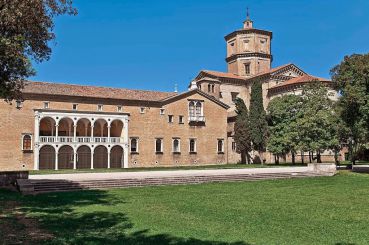Archiepiscopal Museum, Ravenna

The Archiepiscopal Museum (Museo Arcivescovile) in Ravenna keeps a uniquely valuable collection of artworks that became a part of city’s cultural and religious heritage. It is housed in the old beautiful Archiepiscopal Palace. Some of the exhibits make the museum famous all over the world, and the chapel that is included into the tour is listed as a World Heritage site.
History of the museum
In 1730 archbishop Niccolo Farsetti decided to demolish and completely rebuild the ancient Basilica Ursiana. Giovan Francesco Buonamici, an architect from Rimini, was put in charge of this important project. Besides, there were a plenty of very valuable religious items. After the construction was finished the archbishop chose to just keep those objects in a separate room instead of giving them back to the new cathedral. As a result, a new museum was founded in 1734. It became the first diocesan museum in Italy. A lot of ancient pieces were discovered during the reconstruction works that were included in the lapidary collection. In the first half of the 19th century, the museum was modified once again. Next reorganization of museum collections dates back to the early 20th century, in 1909–1919. Enrichment of the collections led to them being expanded and rearranged. In the mid-20th century objects found on archeological sites located within the Eparchy were put on display as well. The museum was restored at the turn of the century, new exhibition building was opened to the public on February 6, 2010.
Museum’s exhibitions
The whole collection is housed in 4 rooms. It is quite impressive since the tour includes a walk through the historical section, archaeological pieces, and artworks. The main part of the collections is located in the lapidary hall which once was the centerpiece of the museum. Various Roman gravestones, sculptures, architectural fragments, mosaics, steles, sarcophagi etc. can be found here. There are, however, exhibits that are the most valuable in the collection:
- Ambone of Saint Paul and John.
- Headless statue. Some believe it is supposed to portray Byzantine emperor Justinian I. It dates back to the 6th century.
- Marble tablet. It has a paschal calendar depicted on it and was made in the 6th century.
- Silver 6th-century crest that belonged to the bishop named Andreas Agnellus.
- Mosaics from the 12th century taken from the Basilica Ursiana.
- Liturgical bishop garments of 10th–11th century.
The most well-known piece in the collection is kept in an ancient Roman tower called Salustra. It is a cathedra or throne of Ravenna’s archbishop Maximian. It was made of precious ivory with masterfully done carving on it. All 24 panels have various episodes from the Bible engraved on them, figures of John the Baptist and the authors of the Gospels are portrayed on the lower front half. It is also decorated with a figure of Jesus Christ, complex ornament, and depictions of plants and animals.
The tour through the museum ends in the archiepiscopal chapel of Andrew the Apostle. This is the only early Christian Episcopal chapel that survived centuries. It houses several fascinating mosaics of the early 5th century. The building was included into the list of World Heritage Sites in 1997.
How to get
The museum is located at the back of the Basilica Ursiana, in the historical center of Ravenna, on Piazza Arcivescovado, 1. There are also other religious constructions in the city which you can enter with the mausoleum ticket, these include the Baptistery of Neon, the basilicas of Sant' Apollinare Nuovo and of San Vitale and Mausoleum of Galla Placidia. The closest bus stop is Ravenna De Gasperi. You can catch buses № 151, 154, 155, 161, 162 there.
Opening hours: from November to February from 10:00 till 17:00, from March to October from 09:00 till 19:00. The ticket office closes 15 minutes before the closing time. Contact number: (+39) 0544 541688.
Admission: a full ticket costs 9,5 euros, a reduced one – 8,5 euros (available for students and groups of 20 people and more.) Children under 10 and persons with disabilities are free of charge.
The information is relevant for July 2018.








